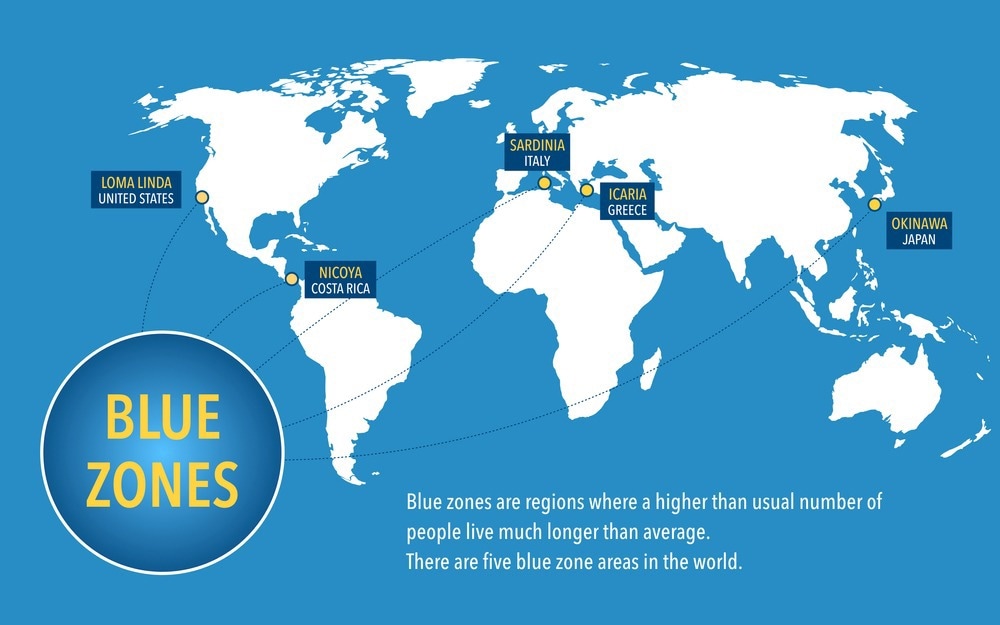- Tags
-
Engels
-
In a world constantly searching for the latest health trends and quick fixes, the concept of "Blue Zones" offers a refreshing perspective. Unlike fad diets or extreme workout routines, Blue Zones represent real communities where people naturally live longer, healthier lives. But what exactly are Blue Zones, and what can we learn from them?
The Origin of Blue Zones
The term "Blue Zones" was first coined by Dan Buettner, a National Geographic Fellow and journalist who, along with a team of researchers, embarked on a journey to identify the secrets behind the world’s longest-lived populations. They found five regions where people consistently live to be over 100 years old and experience remarkably low rates of chronic diseases.These regions are:
Okinawa, Japan: Known for its large population of centenarians, Okinawa is a place where the elderly are revered and stay active well into their later years.Sardinia, Italy: Particularly in the mountainous region of Barbagia, Sardinia boasts a high concentration of male centenarians, thanks to a lifestyle rich in physical activity and strong family bonds.
Ikaria, Greece: This island in the Aegean Sea is famous for its low rates of dementia and chronic diseases, with residents enjoying a diet that’s rich in olive oil, vegetables, and legumes.
Nicoya Peninsula, Costa Rica: Nicoyans benefit from a diet of corn, beans, and tropical fruit, along with a strong sense of purpose and close-knit communities.
Loma Linda, California, USA: Home to a large community of Seventh-day Adventists, Loma Linda residents follow a plant-based diet and engage in regular physical activity, leading to significantly longer life spans.
The Common Denominators of Blue Zones
While these five Blue Zones are scattered across the globe, they share several key characteristics that contribute to the residents’ extraordinary longevity. These common factors, known as the "Power 9," offer a blueprint for living a long and healthy life:Move Naturally: People in Blue Zones don’t engage in structured exercise routines. Instead, their daily lives are filled with natural movement, such as walking, gardening, or doing housework.
Purpose: Having a sense of purpose is a common thread in Blue Zones. Knowing why you wake up in the morning can add up to seven years to your life expectancy.
Downshift: Blue Zone residents have daily rituals that help them manage stress, such as taking naps, enjoying happy hours with friends, or participating in spiritual activities.80% Rule: In Blue Zones, people stop eating when they feel 80% full, which helps them avoid overeating and maintain a healthy weight.
Plant-Based Diet: Meals in Blue Zones are primarily plant-based, with an emphasis on beans, vegetables, and whole grains. Meat is consumed in small portions, typically no more than five times a month.
Wine at 5: Moderate alcohol consumption, particularly wine, is a common practice in Blue Zones, often enjoyed with friends and family.
Belong: A strong sense of belonging, whether through religious faith or community groups, is a key component of Blue Zone lifestyles.
Loved Ones First: Family is a priority in Blue Zones. Elders are cared for at home, and children grow up in nurturing, supportive environments.
Right Tribe: Social networks in Blue Zones are powerful. Residents surround themselves with like-minded people who reinforce healthy behaviors.
Why Blue Zones Matter
The lessons from Blue Zones are not just about living longer—they’re about living better. These communities have managed to achieve what modern society often struggles with: a balance of health, happiness, and longevity. By adopting some of the practices from Blue Zones, we can improve our own well-being and potentially add years to our lives.Incorporating more movement into your day, eating a plant-based diet, and nurturing your relationships are simple, yet powerful, steps you can take to emulate the Blue Zones. It’s not about drastic changes or quick fixes; it’s about making sustainable, small shifts that lead to a healthier, more fulfilling life.
So, the next time you’re looking for ways to improve your health, consider taking a page from the Blue Zones playbook. After all, the best health advice may just come from the people who have been living it for centuries.
